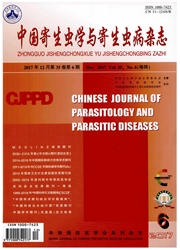

 中文摘要:
中文摘要:
目的 明确我国消除疟疾进程中的风险区域,为有效推动全国消除疟疾进程和全面实施消除疟疾策略提供依据。 方法 收集2010年全国24个疟疾流行省以县为单位的数据,包括各流行县的疟疾流行现状、潜在传播风险和机构工作能力等指标,计算疟疾传播风险评估指数和消除疟疾能力评估指数,定量分析各地疟疾传播风险和消除疟疾能力,对我国消除疟疾进程中的风险区域进行分类,并采用ArcGIS软件绘制我国消除疟疾的风险地图。 结果 收集获得2010年全国24个疟疾流行省2 147个流行县有关疟疾传播风险和消除疟疾能力的数据;统计获得各县能力总评估指数与传播风险指数,结果显示约40%的县在平均线以下;根据疟疾传播风险、疾病防治工作能力及疟疾发病率水平之间关系的三维数据分析结果显示,全国2 147个流行县可分为4类,1类流行县(极高度风险县)共20个,主要分布在云南(9个)、广西(5个)和西藏(1个)等8个省(直辖市、自治区); 2类流行县(高风险县)共17个,主要分布在云南(3个)、广西(2个)、贵州(2个)、陕西(2个)和西藏(1个)等12个省(直辖市、自治区);3类风险县(中度风险县)共170个,主要分布在云南(15个)、贵州(14个)、河北(14个)、四川(13个)、山西(10个)等19个省(直辖市、自治区); 4类风险县(低风险县)共1 940个,在24个省(直辖市、自治区)均有分布。 结论 明确了我国消除疟疾的4类风险区域的分布。
 英文摘要:
英文摘要:
Objective To identify the risk area in China during the malaria elimination process, and provide the evidence for promotion of the national malaria elimination programme and implementation of elimination strategy. Methods Data collection was conducted in 24 endemic provinces in 2010, including data of transmission capacity, potential risk of malaria transmission and the capacity of health professional team at county level. Quantitative assessment of the malaria transmission risk as well as the capacity of health facilities were conducted based on the calculation of malaria transmission risk index (MTI) and health facilities capacity index (CI). ArcGIS 10.0 was used to develop the risk map based on the outcome of quantitative assessment. Results The data of transmission capacity, potential risk of transmission and the capacity of health professional team were collected from 2 147 counties in 24 provinces. Based on MTI and CI calculated for each county, statistic results showed that about 40% of the counties were under the average level of both MTI and CI. The relationship among potential risk of transmission, the capacity of health professional team and malaria incidence were analyzed in three dimensions, and four types were categorized among 2 147 counties. Type Ⅰ(super-high risk area) counties (20) distributed in Yunnan (9), Guangxi (5), Henan (1), Hunan (1), Hebei (1), Sichuan (1), Chongqing (1), and Tibet (1). 17 counties were classified into type Ⅱ(high risk area) area, distributed in Yunnan (3), Guangxi (2), Guizhou (2), Shaanxi (2), Guangdong (1), Jiangxi (1), Hubei(1), Sichuan (1), Gansu (1), Hebei (1), Fujian (1) and Tibet (1). A total of 170 type Ⅲ (moderate risk area) counties distributed in 19 provinces including Yunnan (15), Guizhou (14), Hebei (14), Sichuan (13), Shanxi(10), Guangxi (9), Hunan (9), Anh
 同期刊论文项目
同期刊论文项目
 同项目期刊论文
同项目期刊论文
 期刊信息
期刊信息
